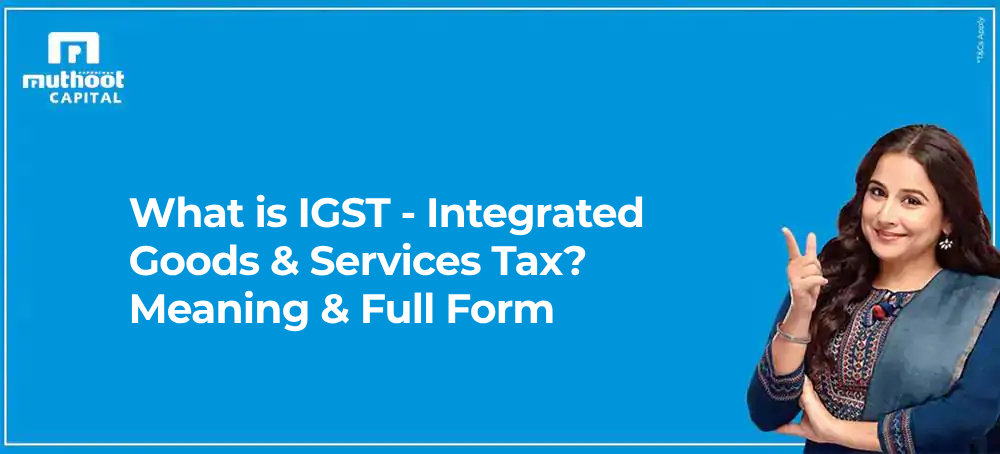What is IGST (Integrated Goods & Services Tax)? Meaning, Full Form, Benefits & Example
Last Modified: 21-January-2025

IGST is a vital part of India’s Goods and Services Tax (GST) system, which revolutionised the country’s tax structure. Introduced to simplify indirect taxes on goods and services, IGST applies specifically to interstate trade, ensuring taxation occurs seamlessly across state borders. This blog will explore the IGST full form, IGST meaning, its features, the differences between CGST, SGST, and IGST, and how it works.
What is IGST?
IGST stands for Integrated Goods and Services Tax. It was implemented under the GST regime, which replaced a complex system of multiple taxes like VAT, service tax, and excise duty. The meaning of IGST is simple—it is levied on interstate transactions or when goods and services move between states. Under this system, the central government collects taxes, and the state where the goods or services are consumed receives a portion of the revenue.
IGST, or integrated tax, ensures that tax on interstate transactions is uniformly distributed between the centre and the states. For example, if a seller in Maharashtra sells a product to a buyer in Gujarat, the tax levied on that transaction would be IGST and the revenue would be shared between the central government and Gujarat.
Key Differences Between IGST, CGST, and SGST
Understanding the CGST, SGST full form and their differences from IGST is essential for grasping the GST framework:
- IGST: Integrated Goods and Services Tax—applicable to interstate transactions
- CGST: Central Goods and Services Tax—levied on intrastate supplies, collected by the central government
- SGST: State Goods and Services Tax—applied to intrastate supplies, collected by the state government
This integrated taxation system simplifies compliance and ensures a consistent approach to tax distribution between the centre and the states.
Read More : Impact of GST on Two wheelers and Bikes in India
Key Features of IGST
IGST has unique features that make it different from other types of GST, such as CGST and SGST. Here’s a breakdown-
1. Interstate Transactions
IGST is applicable when goods and services move across state borders. It also applies to imports and exports, ensuring uniform taxation in cross-border trade.
2. Simplified Tax Collection
Instead of having multiple tax authorities handle tax collection, IGST allows the central government to collect and distribute the tax accordingly, simplifying the process.
3. No Cascading Effect
Like other forms of GST, IGST eliminates the cascading effect of taxes (tax on tax). This reduces the overall tax burden on consumers and promotes transparency in taxation.
4. Input Tax Credit
Businesses can claim an input tax credit (ITC) on IGST paid during interstate purchases, making the tax system more efficient for companies operating across state lines.
5. Uniformity
The same tax rate applies to transactions across different states, providing consistency and fairness in the taxation system.
Difference Between CGST, SGST, and IGST
Understanding the difference between IGST, CGST and SGST is crucial to knowing how the GST system functions. The SGST, IGST and CGST difference helps in understanding the tax jurisdiction for each.
| Aspect | CGST (Central Goods and Services Tax) | SGST (State Goods and Services Tax) | IGST (Integrated Goods and Services Tax) |
| Jurisdiction | Central Government | State Government | Central and State Governments |
| Applicability | Levied on intra-state transactions | Levied on intra-state transactions | Levied on inter-state transactions and imports |
| Tax Credit | Can be set off against CGST or IGST | Can be set off against SGST or IGST | Can be set off against CGST, SGST, or IGST |
| Revenue Sharing | Collected by the Central Government | Collected by the State Government | Shared between the Central and State Governments |
| Purpose | To tax goods and services within a state | To tax goods and services within a state | To tax goods and services across states or imports |
Example
If a company in Mumbai (Maharashtra) sells a product to a buyer in Pune (Maharashtra), CGST and SGST are applicable. However, if that company sells to a buyer in Delhi, IGST will be imposed on the sale.
What to Know About IGST?
When it comes to IGST, it’s essential to understand how it applies to different types of transactions and sectors-
1. Interstate and Intra-State GST
– Intra-state: If a transaction occurs within a state, CGST and SGST are applied.
– Interstate: IGST is applied when goods or services move between two states. IGST is also applicable for imports into India.
2. IGST Percentage
The IGST percentage varies depending on the type of goods or services. It ranges from 5% to 28%, depending on the product category.
3. IGST in Exports and Imports
– Exports: Goods and services exported outside India are subject to IGST, but exporters can claim refunds on IGST paid during export transactions.
– Imports: Goods imported into India attract IGST and other customs duties.
4. Two-Wheeler Finance and IGST
For those availing of Two Wheeler finance to purchase a bike, IGST can impact the overall cost, especially for interstate purchases. It’s important to factor in bike finance interest rates when planning the purchase.
Process for the Refund of IGST
The refund of IGST primarily occurs in cases of exports or when the tax has been paid in excess. Here’s how the refund process works-
1. Eligibility for Refund:
Exporters can claim refunds on the IGST paid for goods or services exported from India. Businesses can also claim refunds for any excess tax paid.
2. Process of Claiming Refund:
– Businesses must file a refund application using GST Form RFD-01 through the GST portal.
– The form should include details of the transaction and the amount of IGST paid.
– After verification, the tax authority processes the refund.
Example of IGST with calculated refund.
The refund amount is calculated based on the IGST paid on the export of goods and services. It also depends on whether the business has claimed input tax credit on purchasing goods and services used for export.
For example, if a company in New Delhi sells goods worth Rs. 1,50,000 to a buyer in Gujarat, with an IGST rate of 18%, the IGST amount would be calculated as follows:
IGST = (Value of Goods * IGST Rate)/100
IGST = (1,50,000 * 18)/100
IGST = Rs. 27,000
Read More : What is RPM in a bike?
Conclusion
IGST, or Integrated Goods and Services Tax, is an integral part of the GST system that governs interstate transactions in India. Its primary function is to create uniformity in taxation across state borders, eliminating the complexities of the previous tax system. With features like input tax credits, uniform rates, and simplifying the tax process, IGST has helped streamline trade across India.
Understanding the difference between CGST, SGST, and IGST, along with the IGST percentage, is crucial for businesses and individuals. Whether you’re a business dealing in interstate trade, an importer or exporter, or simply someone purchasing goods, knowing how IGST works can help you make informed financial decisions.
Being informed is the key to better financial management, from applying for refunds to understanding how IGST can affect two-wheeler finance. With the simplified structure of the GST system, including IGST, India’s tax landscape has become more efficient and transparent.
Frequently Asked Questions
What is the meaning of IGST?
The meaning of an IGST is Integrated Goods and Services Tax.. It is levied on inter-state transactions and imports in India. The IGST is implemented for seamless credit flow between all state governments and the centre, and to make the tax process for cross-border trade simpler.
How do I track IGST refund status?
IGST refund status can be tracked by logging into the GST portal using your login credentials. Navigate to the “Services” tab and select “Refunds”. After that, click on “Track Status.” Enter your refund application details to view the current IGST status and updates related to your refund claim.
Who is taxed under IGST?
IGST is generally levied on inter-state transactions of goods and services and on goods being imported into India. It is applicable to suppliers and recipients involved. In doing so, the credit flow becomes smooth and the tax burden is shared between the central and state governments.
What is the full form of IGST?
The IGST full form is Integrated Goods and Services Tax. This tax applies to interstate transactions, helping streamline taxation across state borders in India.
What is the meaning of IGST, and why is it important?
IGST stands for Integrated Goods and Services Tax. It is levied on interstate trade and imports and plays a key role in ensuring a smooth credit flow and eliminating tax complications across states.
What are the differences between IGST, CGST, and SGST?
The difference between IGST, CGST, and SGST lies in their applicability. While CGST and SGST apply to intra-state transactions, IGST is for inter-state transactions, simplifying tax distribution between the central and state governments.
How is IGST different from CGST?
The IGST and CGST difference is mainly jurisdictional. IGST applies to interstate transactions, while CGST applies within states. Both support a seamless tax system across India.
How does IGST impact imports in India?
When goods are imported into India, they are subject to IGST tax along with customs duties. This aligns with the structure of the integrated tax, ensuring uniform tax treatment for imported goods.
Trending Post
- Guide To Finding The Lower Rate Two-Wheeler Loan
- Tips For Accurate Two-Wheeler Loan Emi Calculations
- Tips To Get A Lower Interest Rate On Two-Wheeler Loan
- Tips For Buying A Bike On Emi With Low Interest
Categories
Need Help?
Please feel free to contact us on toll free number or send us your query on our email.




